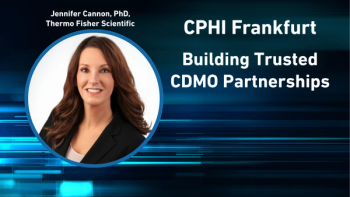
- Pharmaceutical Technology-02-01-2018
- Volume 2018 Supplement
- Issue 1
Outsourcing: Does Focus Pay Off?
Research suggests that working with a single contract partner can reduce development time and improve economics.
Drug development has reached a point where nine out of every 10 new drug candidates fail in the clinic (1). Competitive pressures have led to explosive growth in demand for research and development (R&D) outsourcing, especially as smaller biopharma and pharmaceutical companies play a more prominent role in drug development.
Starting in the 1990s, larger contract development and manufacturing organizations (CDMOs) began to acquire drug substance manufacturers to diversify their business models beyond drug products. Since then, some have added other critical functions such as regulatory affairs and logistics.
As a result, pharmaceutical manufacturers, especially small- to mid-sized companies, are discovering that partnering more closely with one diversified contract company can reduce development time and cost.
CDMOs such as Patheon (now part of Thermo Fisher Scientific) performed their own research to quantify the potential savings. This work resulted in an “Eight Weeks Saved” marketing campaign for Patheon’s integrated service offering, recalls Jennifer Therrien, head of marketing campaign strategy.
But, as outsourcing continued to grow, there was a need for independent testing to validate these claims and quantify the benefits of moving from multiple to single-partner service models. Patheon proposed just such a project to Tufts University’s Center for the Study of Drug Development (CSDD), which took on the project. Patheon funded the work. Results (2) came out in 2017 and were published in a white paper (3) in October 2017, and a paper is expected to be published in Clinical Therapeutics by April 2018.
Using NPV to measure profitability
CSDD grounded the study in the concept of net present value (NPV), a fundamental measure of project or product profitability that is based on the difference between the present values of cash inflows and outflows. Researchers analyzed data from five drug development projects, three involving monoclonal antibodies (mAbs) and two for small molecules, to get an idea of how single-source contracting made a difference. The center used existing data from CSDD’s studies of biopharmaceutical development costs and rates of return, using multi-vendor sourcing as a baseline.
Results showed an average savings of 14 weeks using the single-vendor approach and total gains from reduced development costs and higher net revenues of $44 million. The greatest reduction in chemistry manufacturing and controls (CMC) time was found with small molecules in Phase I, where 19.1 weeks were saved, and in mAbs in Phase III, in which development times were shaved by 19.8 weeks. Overall, these shorter time frames resulted in $20.6 million savings in after-tax development costs.
Reductions in after-tax preapproval development time costs reached $49.3 million for mAbs in Phase III and $18.9 million for small molecules in Phase II. The increase in the present discounted value of after-tax net returns was $32.6 million for small molecules in Phase I and $30.7 million for mAbs in Phase III, with total net gains of $80 million for mAbs in Phase III and $44.5 million for small molecules in Phase I. Tufts CSDD will continue this research, expanding its scope to include more therapeutic categories and may even drug delivery forms, in the future, according to Joe DiMasi, director of economic analysis and research associate professor, Tufts Center for the Study of Drug Development (CSDD).
References
1. J. DiMasi, et al.,
2. J. DiMasi, “Outsourcing Drug Manufacturing: A Study of the Economic Impacts of Single vs. Multi-Vendor Sourcing,” a presentation by the Tufts Center for the Study of Drug Development, October 2017.
3. J. DiMasi, Z. Smith, and K. Getz, “Assessing the Economics of Single-Source vs. Multi-Vendor Manufacturing,” The Tufts Center for the Study of Drug Development White Paper, Tufts University School of Medicine, October 2017.
Article Details
Pharmaceutical Technology
Supplement: Partnerships in Outsourcing 2018
February 2018
Pages: s30Â-s31
Citation
When referring to this article, please cite it as A. Shanley, “Outsourcing: Does Focus Pay Off?," Pharmaceutical Technology Partnerships in Outsourcing 2018 Supplement (February 2018).
Articles in this issue
almost 8 years ago
Accelerating Early Drug Development with Translational Pharmaceuticsalmost 8 years ago
Case Study: Fast-Track Technology Transfer of a Soft-Gelatin Capsulealmost 8 years ago
QbD and API Process Development: A Marriage of Chemistry and Engineeringalmost 8 years ago
Bigger is Better in Samsung's Approach to Biomanufacturingalmost 8 years ago
Outsourcing Analytical Services in Early Drug Developmentalmost 8 years ago
Avoiding Complete Response Lettersalmost 8 years ago
A Three-Step Path Toward Combination Product Approvalalmost 8 years ago
Reducing Development Timelines and CostsNewsletter
Get the essential updates shaping the future of pharma manufacturing and compliance—subscribe today to Pharmaceutical Technology and never miss a breakthrough.




